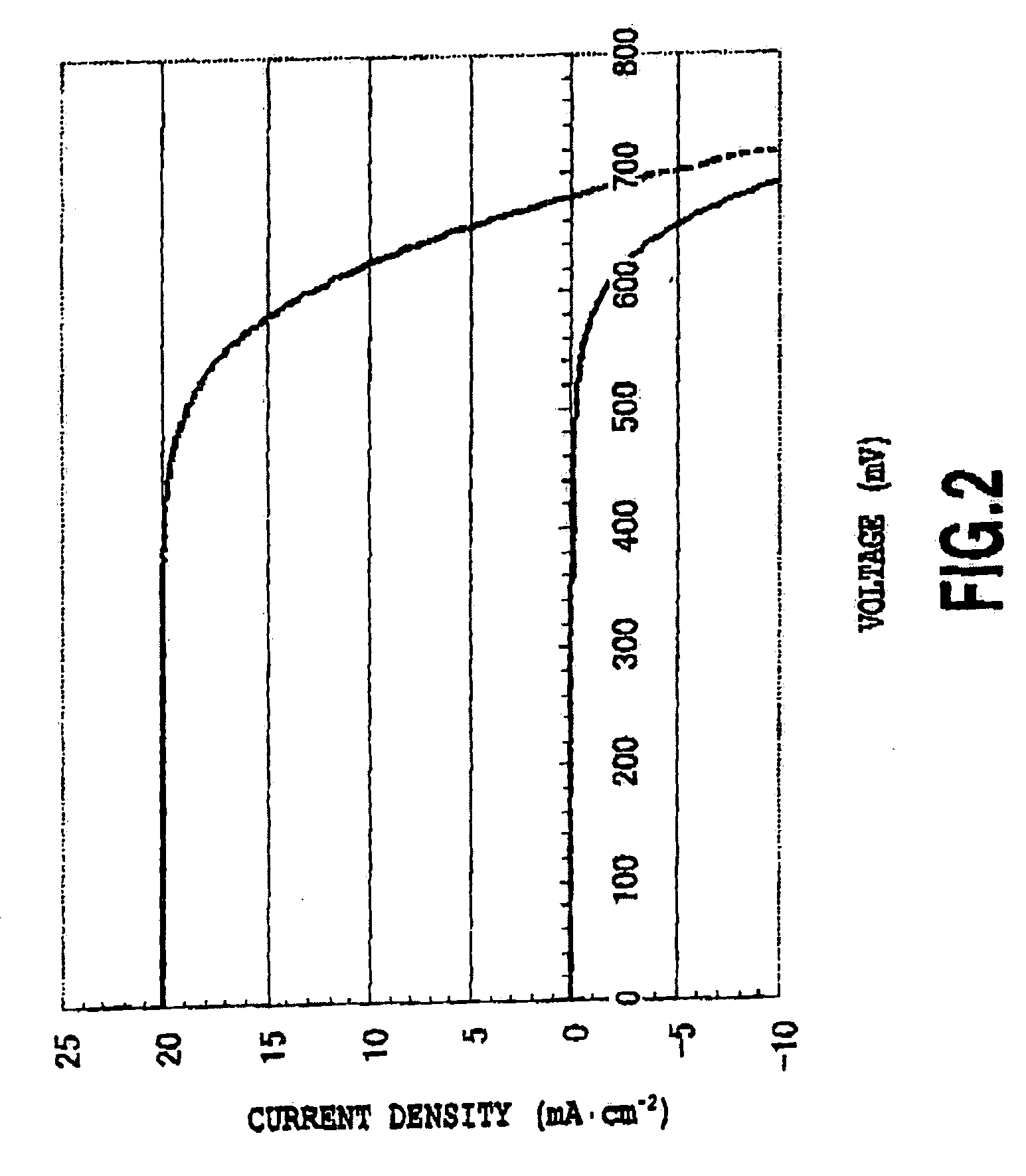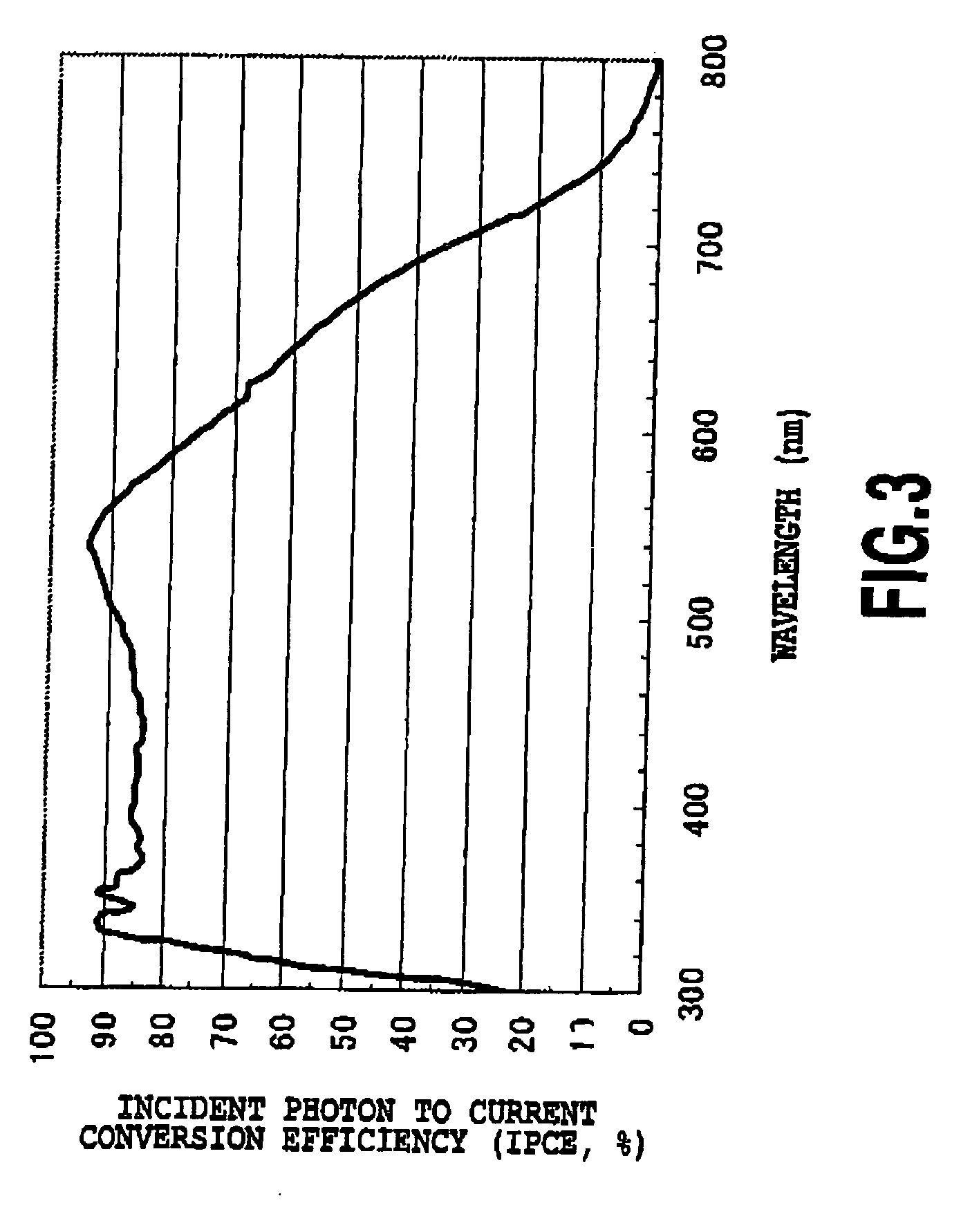Photosensitizer Dye
a technology of photosensitive dye and photosensitive dye, which is applied in the direction of methine/polymethine dye, electrolytic capacitor, electrochemical generator, etc., can solve the problems of high production cost, high production cost, and inability to take on the place of fossil fuels, and achieve high molecular extinction coefficient, excellent stability, and high photoelectric conversion characteristic
- Summary
- Abstract
- Description
- Claims
- Application Information
AI Technical Summary
Benefits of technology
Problems solved by technology
Method used
Image
Examples
synthesis example 1
Synthesis of 4,4′-bis[2-(5-hexyl-2-thienyl)vinyl]-2,2′-bipyridine
(1) Synthesis of 5-hexylthiophene-2-carbaldehyde
[0067]
[0068]Under a nitrogen atmosphere at 0° C., 24 ml of n-butyllithium (1.6M in hexane) were added by dripping to a THF solution containing 2-hexylthiophene (5 g). The solution was then stirred for another 15 minutes and, after adding DMF (5 ml), set to room temperature. The resulting solution was then poured into a IN ammonium chloride solution and extracted with methylene chloride. An organic layer was washed with water and dried with anhydrous magnesium sulfate. A crude product was collected by removing the solvent and then purified by a column chromatograph (carrier: silicon dioxide; eluate: hexane / methylene chloride-4 / 1 (volume ratio)) to obtain 4.6 g of a product.
(2) Synthesis of 4,4′-bis[2-hydroxy-2-(5-hexyl-2-thienyl)ethyl]-2,2′-bipyridine
[0069]
[0070]Under a nitrogen atmosphere at 0° C., 16 ml (0.0256 mol) of n-butyllithium (1.6M in hexane) were added to a dry ...
synthesis example 2
Synthesis of Ru(L3) (L4)(NCS)2(J2)
[0073]L3=2,2′-bipyridine-4,4′-dicarboxylic acid
[0074]L4=4,4′-bis[2-(5-hexyl-2-thienyl)vinyl]-2,2′-bipyridin
[0075]A 10 ml DMF solution of 4,4′-bis[2-(5-hexyl-2-thienyl)vinyl]-2,2′-bipyridine (0.15 g, 0.245 mmol) and dichloro(p-cymene)ruthenium (II) dimer (0.0747 g, 0.122 mmol) was heated by microwave (200 W) under a dark, nitrogen atmosphere at 60° C. for 10 minutes. 2,2′-bipyridine-4,4′-dicarboxylic acid (0.12 g, 0.49 mmol) was then added and heating at 150° C. was performed for 10 minutes. The temperature was then cooled to 100° C., and then ammonium thiocyanate (solution of 0.5 g in 4 ml of water) was added and made to react for 10 minutes at 120° C. The temperature was then lowered to room temperature and DMF was distilled under vacuum. 80 ml of water was added to the residue and the residue was thus immersed for 30 minutes. Insolubles were collected and washed with water and diethyl ether. A crude product was dissolved along with TBAOH (tetrabut...
examples
Performance Evaluation
(1) Absorption Spectrum (FIGS. 1 and 4)
[0077]FIG. 1 shows an absorption spectrum of J2, which is a product according to the present invention. FIG. 4 shows an absorption spectrum of N719, which is a comparative product, measured in the same manner.
(2) Cell Performance Evaluation 1 (FIGS. 2 and 3)
[0078]Titanium dioxide (average particle diameter: 20 nm), prepared by a method in Non-Patent Document 1, was coated to a film thickness of 13 μm onto FTO dielectric glass by a doctor blade method and heating at 450° C. was performed for 30 minutes. A scattering layer (material: titanium dioxide with an average particle diameter of 400 nM) of 4 μm then applied and heating at 500° C. was performed for 20 minutes. The thin film was then treated with 0.05M titanium tetrachloride and then heated at 450° C. for 30 minutes. Titanium dioxide thin films thus obtained were then immersed at 65° C. for 2 hours in the following ruthenium dye solutions, respectively.
[0079]J2: 0.3 mM...
PUM
 Login to View More
Login to View More Abstract
Description
Claims
Application Information
 Login to View More
Login to View More - R&D
- Intellectual Property
- Life Sciences
- Materials
- Tech Scout
- Unparalleled Data Quality
- Higher Quality Content
- 60% Fewer Hallucinations
Browse by: Latest US Patents, China's latest patents, Technical Efficacy Thesaurus, Application Domain, Technology Topic, Popular Technical Reports.
© 2025 PatSnap. All rights reserved.Legal|Privacy policy|Modern Slavery Act Transparency Statement|Sitemap|About US| Contact US: help@patsnap.com



